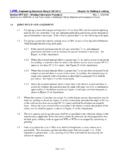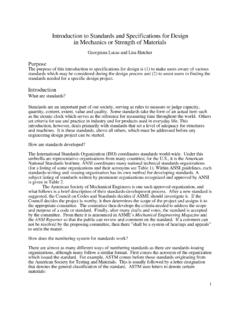Transcription of ANSI/ASME A13 - Pipe Marker
1 4To Order: Call Your Local RepresentativeANSI/ asme Revision ANSI / asme / asme is the most common pipe identification standard used in the United States. The standard specifies the primary and secondary means of identifying pipe content, as well as, the size, color and placement of the identification Primary IdentificationThe legend (name of pipe content) and directional flow arrow remain the primary means of identifying pipe content. The size and placement of the Marker and arrow has not changed. See ANSI / asme size table and installation recommendations for should use arrows to indicate direction of flow. Where flow can be in both directions, arrows in both directions should be displayed. Contents should be identified by a legend with sufficient additional details such as temperature, pressure, as are necessary. Legends should be brief, informative, pointed, and simple for greatest Secondary IdentificationASME Color: Color should be used to identify the characteristic hazards of the contents.
2 Color should be displayed on, or contiguous to, the piping by any physical means, but its use shall be in combination with a legend. Color may be used in continuous, total-length coverage or in intermittent displays. Colors preceded by the word Safety shall meet the requirements of ANSI/NEMA Flammable Fluids: Used for fluids that, under ambient or expected operat-ing conditions, are a vapor or produce vapors that can be ignited and contin-ue to burn in air. The term thus may apply, depending on service conditions,to fluids defined for other purposes as flammable or Fluids: Oxidizing fluid is any gas or liquid that may, generally by providing oxygen, cause or contribute to the combustion of other material more than air Quenching Fluids: This classification includes water, foam and CO2 used in sprinkler systems and fire fighting piping & Corrosive Fluids: This classification includes fluids that are corrosive or toxic, or will produce corrosive or toxic substances when Fluids.
3 This classification includes fluids that can burn, but are not Service ColorsFlammable & Oxidizing Fluids Yellow/BlackPotable, Cooling, Boiler Feed & Other WatersGreen / WhiteCompressed AirBlue / WhiteFire Quenching FluidsRed / WhiteToxic & Corrosive FluidsOrange / BlackCombustible FluidsBrown / WhiteDefined by UserPurple / WhiteDefined by UserWhite / BlackDefined by UserGray /WhiteDefined by UserBlack/WhiteANSI / asme Additional Means of Identification asme incorporated the GHS pictograms into the 2015 revision and has recommended their use as part of the legend. The applicable GHS pictograms as illustrated in Fig. 1 may be included as part of the legend. Where piping is connected to containers that are labeled in accordance with GHS requirements, a corresponding label on the piping may be provided. The corresponding label should contain at least the product name or identifier, the pictogram, the signal word, and the physical, health and environmental hazard statements.
4 Fig. 1 GHSMARKERSONPG 395 Call 800-274-6271 or Order Online at Abandoned PipingPiping that has been abandoned in place should be identified. The recommended color scheme is safety white background with black letters. A black border should be added to the identification. When the abandoned piping is protected from corrosion by the addition of a pressurized fluid or contains residual hazardous material, the legend should indicate ANSI / asme Size Chart (Pipe Overall Diameter, Marker Size & Letter Height)The following chart shows the recommended pipe Marker letter height and Marker size based on the outside pipe diameter, including insulation of the pipe to be identified. For pipes with an smaller than 3/4 (19mm) and for valve and fitting identification, the use of a permanent legible tag is with Diameter ( ) to (18 to 33 mm) Marker Length: 8 (200 mm)Legend Height: (13 mm)Pipes with Diameter ( ) to (34 to 61 mm) Marker Length: 8 (200 mm)Legend Height: (19 mm)Pipes with Diameter ( ) to (62 to 170 mm) Marker Length: 12 (300 mm)Legend Height: (32 mm)Pipes with Diameter ( ) to 10 (171 to 254mm) Marker Length: 24 (600mm)Legend Height: (64mm)Pipes with Diameter ( )Over 10 (Over 254mm) Marker Length: 32 (800mm)Legend Height: (89mm)3.
5 PlacementAlways position pipe labels on pipes to achieve the best visibility. Install pipe labels below or above the horizontal centerline of the pipe when pipes are located above or below the normal line of pipe labels adjacent to changes in direction and/or pipe labels close to valves or flangesInstall pipe labels before and after all wall, floor and ceiling pipe labels at frequent intervals on straight pipe runs. Brimar recommends 20 to 25 ft.

